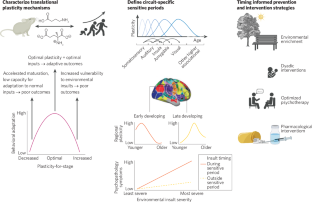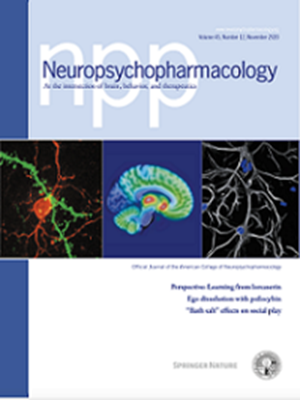Measuring neuroplasticity in human development: the potential to inform the type and timing of mental health interventions
IF 6.6
1区 医学
Q1 NEUROSCIENCES
引用次数: 0
Abstract
Neuroplasticity during sensitive periods, the molecular and cellular process of enduring neural change in response to external stimuli during windows of high environmental sensitivity, is crucial for adaptation to expected environments and has implications for psychiatry. Animal research has characterized the developmental sequence and neurobiological mechanisms that govern neuroplasticity, yet gaps in our ability to measure neuroplasticity in humans limit the clinical translation of these principles. Here, we present a roadmap for the development and validation of neuroimaging and electrophysiology measures that index neuroplasticity to begin to address these gaps. We argue that validation of measures to track neuroplasticity in humans will elucidate the etiology of mental illness and inform the type and timing of mental health interventions to optimize effectiveness. We outline criteria for evaluating putative neuroimaging measures of plasticity in humans including links to neurobiological mechanisms shown to govern plasticity in animal models, developmental change that reflects heightened early life plasticity, and prediction of neural and/or behavior change. These criteria are applied to three putative measures of neuroplasticity using electroencephalography (gamma oscillations, aperiodic exponent of power/frequency) or functional magnetic resonance imaging (amplitude of low frequency fluctuations). We discuss the use of these markers in psychiatry, envision future uses for clinical and developmental translation, and suggest steps to address the limitations of the current putative neuroimaging measures of plasticity. With additional work, we expect these markers will significantly impact mental health and be used to characterize mechanisms, devise new interventions, and optimize developmental trajectories to reduce psychopathology risk.


测量人类发展过程中的神经可塑性:为心理健康干预措施的类型和时机提供信息的潜力。
敏感期的神经可塑性是指在环境高度敏感的窗口期,神经对外界刺激做出持久反应的分子和细胞过程,它对于适应预期环境至关重要,对精神病学也有影响。动物研究揭示了支配神经可塑性的发育顺序和神经生物学机制,然而我们在测量人类神经可塑性方面的能力差距限制了这些原理的临床转化。在此,我们提出了神经影像学和电生理学测量指标的开发和验证路线图,以开始弥补这些差距。我们认为,对追踪人类神经可塑性的测量方法进行验证,将有助于阐明精神疾病的病因,并为精神健康干预措施的类型和时机提供信息,从而优化干预效果。我们概述了评估人类可塑性的神经影像学假定测量方法的标准,包括与动物模型可塑性的神经生物学机制的联系、反映生命早期可塑性增强的发育变化以及对神经和/或行为变化的预测。这些标准适用于使用脑电图(伽马振荡、功率/频率的非周期性指数)或功能性磁共振成像(低频波动幅度)对神经可塑性进行的三种假定测量。我们讨论了这些标记在精神病学中的应用,展望了未来在临床和发展转化中的应用,并提出了解决目前可塑性的假定神经影像测量局限性的措施。通过更多的工作,我们预计这些标记将对心理健康产生重大影响,并可用于描述机制、设计新的干预措施、优化发展轨迹以降低精神病理学风险。
本文章由计算机程序翻译,如有差异,请以英文原文为准。
求助全文
约1分钟内获得全文
求助全文
来源期刊

Neuropsychopharmacology
医学-精神病学
CiteScore
15.00
自引率
2.60%
发文量
240
审稿时长
2 months
期刊介绍:
Neuropsychopharmacology is a reputable international scientific journal that serves as the official publication of the American College of Neuropsychopharmacology (ACNP). The journal's primary focus is on research that enhances our knowledge of the brain and behavior, with a particular emphasis on the molecular, cellular, physiological, and psychological aspects of substances that affect the central nervous system (CNS). It also aims to identify new molecular targets for the development of future drugs.
The journal prioritizes original research reports, but it also welcomes mini-reviews and perspectives, which are often solicited by the editorial office. These types of articles provide valuable insights and syntheses of current research trends and future directions in the field of neuroscience and pharmacology.
 求助内容:
求助内容: 应助结果提醒方式:
应助结果提醒方式:


